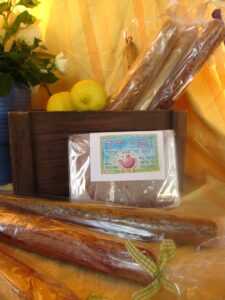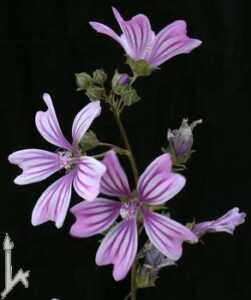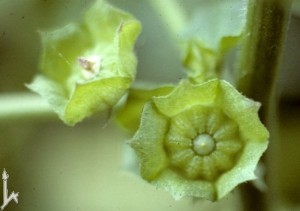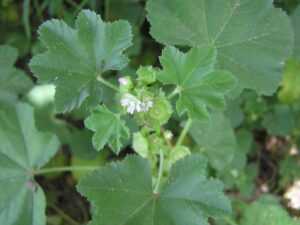 Melissa of Mipri Yadeha is preparing a special, creative line of delectable products for Mishlochei Manot:
Melissa of Mipri Yadeha is preparing a special, creative line of delectable products for Mishlochei Manot:
- § The Scroll of Esther–distinctive, hand-fashioned leather scrolls in a royal package: fruit leather in select flavors: lemon-mint, passion fruit, kiwi, apple-ginger, guava, pomegranate and more. 30 NIS per scroll.
- § Leather Mishlochei Manot – including four wonderful flavors: 10 NIS per package
_________________________________________
To add joy to the month of Adar, we are doing our own little V’Nahafochu, and supplying you with generous amounts of weeds. And not just any weed! This is (drumroll)……………….the Chubeza itself (in the flesh)!
It is really beautiful, charming, and bears a very different taste–of the wild, of nature and freedom. May our chubeza bring all of this and more to your month of Adar.
Chubeza
There is a one place, called Chubeza, not far from Tel Aviv. I am told people wear black in Chubeza, and are always happy. “I don’t believe in all that crap,” said my best friend, and really, he just wanted to say that he doesn’t believe happy people exist. Lots of people don’t believe this. So I got on a bus to Chubeza, and listened to war songs on my walkman. People in Chubeza never die at war. People in Chubeza don’t go to the army. I got off the bus at the main square. The people of Chubeza received me quite well. From up close, it was evident that they really are happy. They dance a lot, in Chubeza, and they read thick books. And I danced with them, in Chubeza, and read the thick books. And I wore their clothes in Chubeza and slept in their beds. And I ate their food in Chubeza and kissed their babies on the mouth. This went on for three whole weeks. But happiness is not contagious.
Etgar Keret, from Pipelines
Some nine years ago, when we were just beginning to cultivate the first field, we searched for a name. My creative source for names was my spouse, Yisrael, who tossed out all sorts of ideas that were deliberated and tested. But you know what it’s like….nothing seemed to stick.
I think it was getting close to April and I knew we would have to choose. It was a Saturday at the end of winter. Three of us sat together, Yisrael, my sister and me, when all of a sudden, out of the blue, appeared the name “Chubeza” (mallow). Something rang true. My sister then remembered this story by Etgar Keret, something to do with happy people. The name was beginning to grow on us. We bought the book, found the story (above), and I researched mallow to find other reasons to finalize the choice.
Chubeza carries the scents of childhood, and reminded us all of the small mallow fruits we would pick, peel and toss into our little mouths. The name derives from the Arabic word for bread, which made it nice, being a label of something basic, natural, simple. There were also the stories of people cooked mallow cutlets during the siege on Jerusalem. Finally, the mallow is a weed, and my affinity for weeds, their survival instincts and abundance went quite well with the concept of an organic farm that lives with nature without trying to subdue it. The die was cast. That evening we celebrated with a ceremonious dinner of pastries stuffed with mallow leaves, nettle and mustard from our wild garden at home.
Mallow belongs to the Malvaceae family, like its cousin, okra. It grows all over the country in places where the earth is rich with nitrogen, in abandoned spots, at roadsides, dunghills, fallow fields and settlements. Its root is skewer-like, its stem covered with thin hair. The leaves are roundish, sometimes shaped like a hand, cut to lobes with sharpened edges. They are bluish-pink. The fruit is a schizocarp, meaning it separates to molecules once it ripens, and those are shaped like a cake or a small tarbush.
The chubeza is an important and very nourishing vegetable. More about this below, but along with its nutritional value, chubeza boasts medicinal merits known for years in folk medicine. Nisim Krispil quotes the Mishna which names the mallow as a plant that contains in its stem liquids that were used for preserving seeds. This is true—all parts of the plant contain a disinfecting mucous, very effective against the common cough, disturbances in the respiratory system or urinary tract, and as a proven cure for necrosis wounds, burns and skin diseases, infections in the delicate female genitalia, urinary tract and kidney diseases, and even as a shampoo and hair strengthener. Cook 250 g of chubeza greens in half a liter of water for 30 minutes (250 g take up a lot of space, but they shrivel as they cook). You will get a lump of moist spinach-like greens. Squeeze out the water (and save the liquid), then mash the greens for porridge, manually or with a food processor. Add half a cup of olive oil to this balm, and spread over burns, necrosis wounds and as a balm for skin diseases. The mixture can be refrigerated in a sealed glass bowl. The cooking liquid is rich in attributes as well. Drinking it is good for the common cough, eases disturbances in the respiratory system and urinary track and cures infections in the female genitalia. Washing your hair with this water strengthens the roots and prevents hair loss.
And what about the gastronomic aspect? The leaves and stems of the mallow have been used in the Arabic kitchen for years. Our Kurdish landlady in Moshav Nes Harim used to make delicacies from mallow: she stuffed them like grape leaves, cooked them in kubeh soup or tossed them in an omelet. A major advantage of chubeza is that it’s so easily available, growing wild everywhere as a weed. In 1948, in besieged Jerusalem, the residents picked it and ate the leaves and fruit (termed to this day “Jerusalem bread) and made chubeza cutlets.”The Voice of the Defender”radio station used to broadcast recipes, cooking guides, and food shows. These broadcasts were picked up in Jordan, and Radio Amman announced that “the Jews are eating mallow, which is food for donkeys and animals, a sure sign that Jerusalem is about to fall into our hands, as the Jews are dying of starvation.” During the 30th Israeli Independence Day celebrations, children were sent on a nostalgic hunt for chubeza leaves, which were frozen by “Sunfrost” and sold at a symbolic price. Recipes from the siege were distributed as well. But the mallow is not only a default option. It really is delicious and extremely nutritious, all by itself.
In Arab markets in the Galilee and Jerusalem, one can find bunches of various wild weeds, among them the mallow, sold for home cooking. The veteran Jerusalem restaurant Eucalyptus serves gourmet dishes of wild weeds gathered by the chef in the Jerusalem Hills. In terms of nutritional value, mallow is a treasure. It is rich in iron (almost 13 mg per 100 g, compared with 1-2 mg in broccoli, for instance) and in vitamins A and C. Eating chubeza leaves will improve your eyesight. Mallow is rich in vitamin A, containing 12 times more vitamin A than the carrot!
Some Tips:
The mallow we send you is organic, from our field. But we recommend you go out and pick some for yourselves, along with other weeds (wood-sorrel, purslane, chard and mustard) which grow wild all over the country. If you’re gathering mallow leaves (or other wild flowers), be careful. Do not pick them from roadsides where they are probably polluted by auto exhaust, and try to skip locations where you think the city or the occasional neighbor may be spraying with weed killers. Best to find them in the rough, which you can do on occasion, and in abandoned areas where the wild of nature grows undisturbed.
Good luck, enjoy the adventure, and… bon appetite!
Wishing you a joyful month of Adar, and New Year’s greetings to Lobsang as he celebrates Losar, the Tibetan New Year.
Alon, Bat Ami and the Chubeza team
________________________
WHAT’S IN THIS WEEK’S BOXES BESIDES OUR GLORIOUS CHUBEZA?
We’ve picked a green bunch of chubeza for you as a special addition to your box. And, alongside this amazing green are the following “cultured” vegetables:
Monday: chubeza (mallow), lettuce, cauliflower, tomatoes, peas/fava beans/ broccoli, carrots, radishes, cucumbers, fennel, kale/tatsoi, coriander/parsley, chubeza (mallow) greens, cabbage (small boxes only)
In the large box, in addition: Leeks, sweet red/yellow peppers, parsley root, kohlrabi
Wednesday: chubeza (mallow), green or red cabbage, cucumbers, red or yellow peppers, kohlrabi, lettuce, parsley root, kale or Swiss chard, beets or radishes, carrots, tomatoes, leeks – small box only
In the large box, in addition: fennel, cauliflower or potatoes, peas or broccoli, dill or cilantro
________________________
Chubeza Recipes
For days under siege and for holidays………Enjoy!
Chubeza Stew—-Moshe Bason, “Eucalyptus Restaurant” (of blessed memory)
Ingredients:
750 grams chopped chubeza (leaves and stems)
3-4 T. olive oil
2 onions, finely chopped
4 garlic cloves, sliced
½ c. water
Salt and freshly ground black pepper
For serving: a bit of techina and lemon slices
Preparation:
–In a skillet, brown the onions in olive oil. Add the garlic and the chubeza and sauté lightly while stirring.
–Add water and cook around 15 minutes over low heat.
–Season with salt and pepper, and serve hot with a bit of techina on top and lemon slides along the side.
Chubeza Cutlets–—-Moshe Bason, “Eucalyptus Restaurant” (of blessed memory)
Ingredients:
3 cups chubeza greens, sliced in thin strips
2 medium onions, cut in half and sliced thinly
4 sprigs of nana (mint), chopped
3 matzot, crushed to matza meal
3 garlic cloves
3 eggs
1 t. nutmeg, grated
Black pepper to taste
1 t. salt
30 chubeza fruits
Oil for frying
Preparation:
–Process all ingredients into a dough; add the egg and matza meal as needed.
–With wet hands, form small flat cutlets, place a chubeza fruit on top, and fry in hot oil till browned.
–Serve hot with lemon slices. You may also prepare a sauce from lemon, olive oil, garlic and turmeric + 1 t. sugar and water, and cook the cutlets in the sauce for 10 minutes.
Chubeza Soup
Ingredients:
One bunch of chubeza greens (washed and torn into medium-size pieces)
Chopped onion
Rice
Lemon
Salt, pepper
Preparation:
–In a covered pan, steam the greens with a bit of water over a low heat
–Sauté onion till golden
–Cook rice a bit till it softens
–Add the onion and the rice to the greens, add water, cook as soup, and season to taste.
Chubeza Pie
Ingredients:
50 grams chubeza greens, blanched and chopped
200 grams ricotta cheese
100 milliliter sweet cream (shamenet metuka)
3 eggs
Salt/pepper/nutmeg to taste
Preparation:
–Mix ricotta, eggs, sweet cream, and spices. Add the greens. Bake 25-30 minutes at 180°. It’s delicious!




